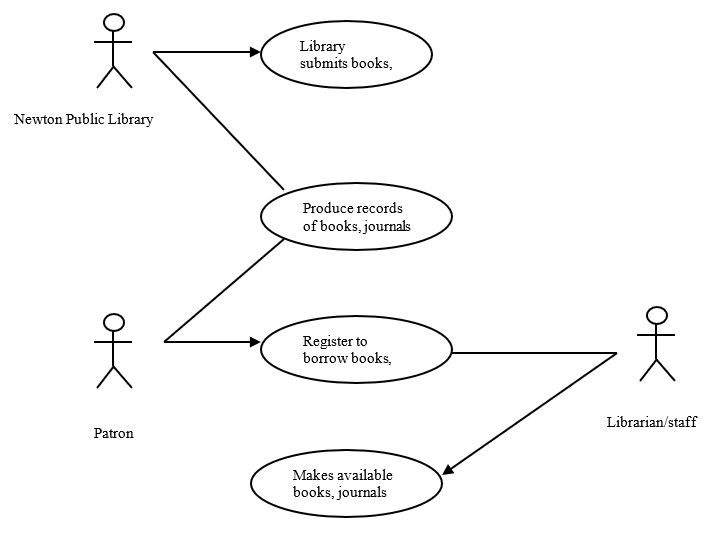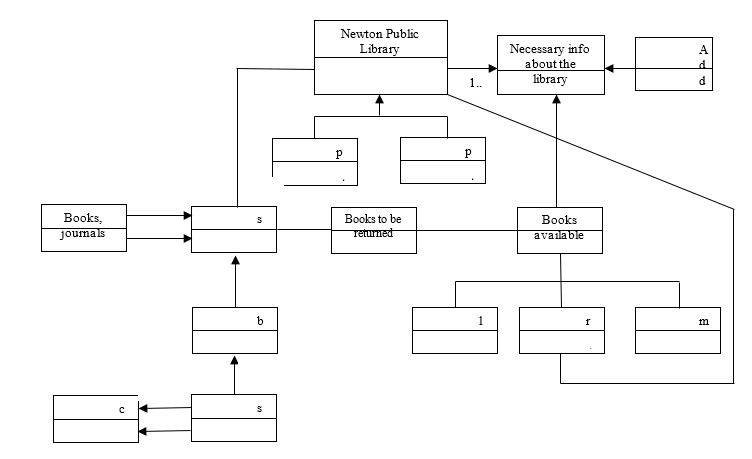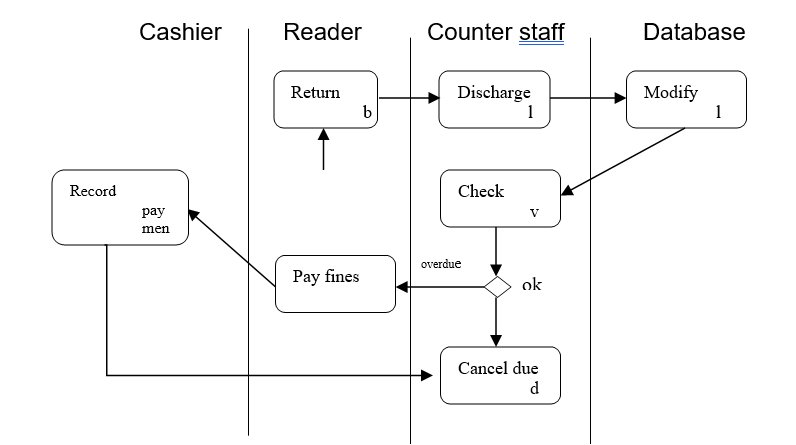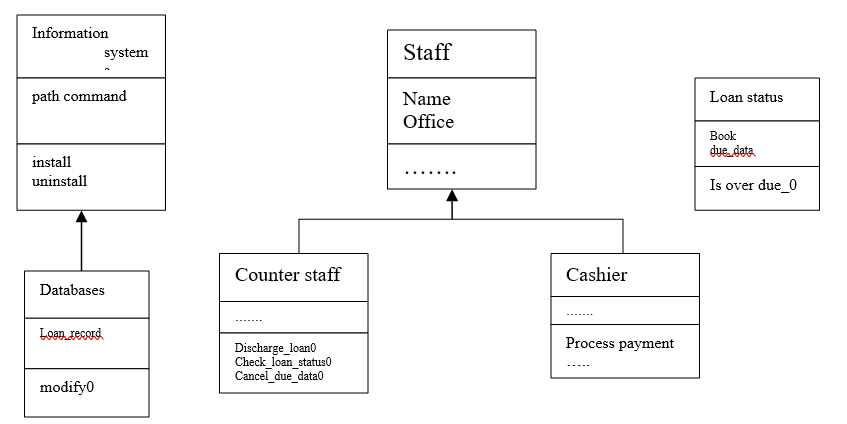Issues in the existing information system of the Newton Public Library
The Newton Public Library operates through the kindness and donations of benefactors, especially Mr. Jimmy Chung. Ever since its inception, it has run through the manual or traditional system, except perhaps a few modifications when computers and the Internet became popular. The librarian insists that the library doesn’t dwell in the past, but it is clear that the system being used is still ‘past tense’ for the Newton Public Library. Now they want to modernize, use an information system, and go online to make operations, services and borrowing become automatic for Ms. Peri and the staff who want a new system.
The Information System of the Newton Public Library is still manual. Or, there is precisely no Information System at all, no online connection, except the manual type of registering and borrowing of books and using the services of an old library. There is one aspect that is not clear in the description: that the library system ‘should periodically check’ the overdue borrowing by a patron, and if so, notice should be sent to the patron. There are unanswered questions in the situational description of the Newton Public Library.
The library needs an information system that should conduct the following tasks:
- A ‘librarian’ that conducts periodical checking whether a copy of a book and any reading material has been overdue and notice should be sent to the patron in question. This is an ‘automatic librarian’ that conducts periodical checking and precisely does not need the services of a human librarian.
- A record or register of the patrons or borrowers, whether new or old ones;
- The patrons or borrowers can reserve a book or journal, and this should be recorded in the system which automatically cancels the reservation once it is attained and sends notice that it is now available.
- The system should record titles of books or journals that are in demand and send notices to the staff or book suppliers that titles or copies have to be purchased or sent right away to the library.
- The system can automatically create, delete, update the information on books, journals and other reading materials according to the input made by patrons and staff.
The Event list for the Newton Public Library can be described here.
- Library submits information on books and journals.
- Time to produce information, data and records on books and journals.
- Patron registers to borrow books or journals.
- The library makes available books or journals.
- Patron is able to borrow books.

Use case: Borrow book or journal from the library
Actor: Library patron
Purpose: To borrow a book and record the information about the book or journal.
Overview: The patron inputs the information about the title of the book or journal. The system checks the information back if the title is present in the database, and if there are copies available. The system provides the information if there are titles and copies available for borrowing.
Type: Essential
Preconditions: The borrower is a registered patron. Titles and copies are existing and available for use.
Postconditions: Patron was able to borrow books or journals from the Newton Public library.
Flow of Events
Actor Action
System Response
- The patron logs in to use the services of the library.
- The patron inputs information of book.
- Adds the title and or journal (author, date of publication, etc.) respond if a copy is
- The student indicates that all information is available of the book/journal is complete.
- States availability of title or copy and informs the staff of action to be taken.
Alternative Flow of Events
Invalid patron information (user and password). Error detected. Return to Step 1.
Invalid title of the book; error in the information. Error detected. Go back to step 2.
Typical Domain Model of the Newton Public Library
The first thing that the consulting firm, People and Objects Inc. represented by Dewey, should do is documentation. This is what he has been doing when he entered the Newton Public Library, taking down notes, asking what Peri Otticle, the director of the library, would want of the Information System to perform and analyze the existing information system of the library if there is any. For effective implementation, development and use of an information system, documentation is of paramount importance. (Jesus and Carapuca, 1992, p. 48)

In a typical domain for public libraries, some functional commands need to be incorporated into Information systems. Process modeling involves several steps which put the entire work into an easy job for the librarian and the user or patron who loans and borrows books and journals. (Hasibuan and Santoso, 2004, p. 913)
These commands or basic function domains include ‘return book’ or ‘loan book’. They have to be specified as ‘mandatory’ and other alternative functions. (Berztiss, 1994, p. 8)
Other alternative functions include ‘expected’ or ‘optional’, or other words which the application system requires. However, software models for libraries have to be flexible so they can deliver the necessary functionalities. (Royce, p. 315)
Some of the goals that can be considered significant in a typical domain model for a public library include:
- ‘return book’ – This has to be regarded as ‘mandatory’. Patrons of Newton Public Library have to return their borrowed books before they become overdue. Warnings should be sent to patrons and penalties can be imposed on patrons with overdue books.
- ‘loan book’ – Another ‘mandatory’ mark for this type of function. Patrons with validated library membership cards can use the services of the Newton Public Library.
- ‘reserve book’ – This is another ‘mandatory’ function. Reservation of a book with no copy available can be availed of by any patron.
- ‘renew book’ – With a ‘mandatory’ mark, any patron can renew borrowing the book for as long as it is not reserved by another patron or member.
- ‘query book’ – With another ‘mandatory’ function, any patron can query the availability of a title or copy of a book.
- ‘reader satisfaction’ – This function can be marked with the word ‘expected’. Patrons who have borrowed or loaned books and journals are expected to be satisfied with the services of the Newton Public Library.
- ‘low daily cost’ – Running the Newton Public Library, which operates on donations and the kindness of philanthropist, Mr. Jimmy Chung, has got to below.
Another command can be ‘low construction cost’ for the Newton Public Library, which can be regarded as ‘optional’. The mandatory commands described above are basic commands and behavior of an information system and have to be incorporated into the domain model of the library. These are requirements that tell what the system can act or respond to the command. (Sullivan, 2007, p. 731)
Functional requirements tell us how the system acts to the command, and the non-functional requirements tell how the information system for the Newton Public Library behaves in the context of ‘performance, reliability and reusability’ (Gaudes et al., 2001, p. 539).
Activity diagram for ‘borrow’, ‘loan’ or ‘return’ – Newton Public Library

Cashier Reader Counter staff Database
The workflow design in the figure above can tell us how the system works and how we can introduce functions and make commands to the information system for the Newton Public Library. This is the loan-return process of the functional requirements for the library. As soon as a library patron returns a book, the staff will push the button for ‘discharge loan’ and modify it in the database. This is a separate activity for the database, i.e. ‘modify loan record’. The loan status will be checked by the staff, whether it is normal, or not overdue, and if it has not violated the due date requirement, the staff will cancel the ‘overdue’ data. But if the patron violates the overdue date, he/she has to pay a penalty, i.e. according to the regulations of Newton Public Library. The process will go to the cashier where the patron has to pay the penalty.
A class diagram for Newton Public Library management

This is also a web-enabled process and domain model. The staff handles the input and output processes by validating some information about the patron or borrower. If the discharge is to be executed, it can be represented by 1, and if no action is needed, it can be represented by 0 in the system. The staff and counter staff can do the action and counter-action to ensure an effective process. This actually requires pushes of buttons. (Boehm, 2000, p. 737)
There are some weaknesses that can be detected, for example, inaccurate data and information coming from the patron. This has to be accurate. Moreover, the process has to be tested for its efficiency.
The strength is that it has simplified the process and made library service exciting for both the patrons and the staff of Newton Public Library.
References
Baran, R. J, Galka, R. J. and Strunk, D. P., 2008. Customer relationship management. Mason, OH: Thomson South-Western. p. 304.
Berztiss, A. T., 1994. Natural and formal languages in the development of information systems. In: R. P. van de Riet, J.F.M. Burg, and A.J. van der Vos (eds.), Applications of natural language to information systems. Oxford, England: IOS Press/Lavis Marketing. p. 8.
Boehm, B., 2000. Project termination doesn’t equal project failure. In: R. Selby (ed.), Software engineering: Barry W. Boehm’s lifetime contributions to software development, management, and research. New Jersey: John Wiley & Sons, Inc. p. 737.
Boehm, B. W. and Jain, A., 2007. An initial theory of value-based software engineering (2005). In: R. Selby (ed.), Software engineering: Barry W. Boehm’s lifetime contributions to software development, management, and research. New Jersey: John Wiley & Sons, Inc. p. 777.
Docstoc.com, 2009. DFDs (Data Flow diagrams) Examples. Web.
Gaudes, A., 2001. Virtual transactional and relational exchanges: the enabling effects of information technology. In: M. Khosrowpour (ed.), Managing information technology in a global economy. London, UK: Idea Group Publishing. p. 539.
Hasibuan, Z. A. and Santoso, H. B., 2004. Online academic administration system to support distance learning at faculty of computer science university of Indonesia. Web.
Holden, S. I., 1992. A knowledge based technique for the process modeling of information systems: the object life cycle diagram. In: P. Loucopoulos (ed.), Advanced information systems engineering: 4th international conference CAiSE ’92, Manchester, UK, May 1992 Proceedings. Manchester, UK: Springer-Verlag. p. 164.
Imai, M., 1986. Kaizen. London: Random House. p. 2.
Jesus, L. and Carapuca, R., 1992. Automatic generation of documentation for information systems. In: P. Loucopoulos (ed.), Advanced information systems engineering: 4th international conference CAiSE ’92, Manchester, UK, May 1992 Proceedings. Manchester, UK: Springer-Verlag. p. 48.
Royce, W., 2007. Introduction. In: R. Selby (ed.), Software engineering: Barry W. Boehm’s lifetime contributions to software development, management, and research. New Jersey: John Wiley & Sons, Inc. p. 315.
Sullivan, K. J., 2007. Value-based software engineering. In: R. Selby (ed.), Software engineering: Barry W. Boehm’s lifetime contributions to software development, management, and research. New Jersey: John Wiley & Sons, Inc. p. 731.